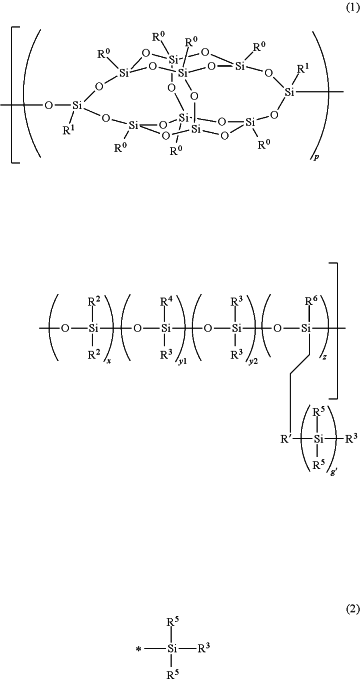| CPC C08L 83/04 (2013.01) [C08G 77/06 (2013.01); C08G 77/12 (2013.01); C08G 77/16 (2013.01); C08G 77/18 (2013.01); C08G 77/20 (2013.01); C08G 77/24 (2013.01); C08G 77/26 (2013.01); C08G 77/28 (2013.01); C08G 77/30 (2013.01); C08G 77/70 (2013.01); C08G 77/80 (2013.01)] | 19 Claims |
|
1. A siloxane polymer comprising a repeating unit represented by Formula (1):
 in the above formula, R0's independently represent an aryl group having 6 to 20 carbon atoms or a cycloalkyl group having 5 to 6 carbon atoms, and in the aryl group having 6 to 20 carbon atoms and the cycloalkyl group having 5 to 6 carbon atoms, any hydrogen atom may be independently substituted with a fluorine atom or an alkyl group having 1 to 20 carbon atoms;
R1's independently represent a hydrogen atom, an aryl group having 6 to 20 carbon atoms, a cycloalkyl group having 5 to 6 carbon atoms, an arylalkyl group having 7 to 40 carbon atoms, or an alkyl group having 1 to 40 carbon atoms, in the aryl group having 6 to 20 carbon atoms, the cycloalkyl group having 5 to 6 carbon atoms and the aryl group in the arylalkyl group having 7 to 40 carbon atoms, any hydrogen atom may be independently substituted with a fluorine atom or an alkyl group having 1 to 20 carbon atoms, in the alkylene group in the arylalkyl group having 7 to 40 carbon atoms, any hydrogen atom may be substituted with a fluorine atom, any —CH2— may be independently substituted with —O—, —CH═CH—, or a cycloalkylene group having 5 to 20 carbon atoms, in the alkyl group having 1 to 40 carbon atoms, any hydrogen atom may be independently substituted with a fluorine atom, and any —CH2— may be independently substituted with —O— or a cycloalkylene group having 5 to 20 carbon atoms;
R2, R4, R5 and R6 independently represent an aryl group having 6 to 20 carbon atoms, a cycloalkyl group having 5 to 6 carbon atoms, an arylalkyl group having 7 to 40 carbon atoms, or an alkyl group having 1 to 40 carbon atoms, in the aryl group having 6 to 20 carbon atoms, the cycloalkyl group having 5 to 6 carbon atoms and the aryl group in the arylalkyl group having 7 to 40 carbon atoms, any hydrogen atom may be independently substituted with a fluorine atom or an alkyl group having 1 to 20 carbon atoms, in the alkylene group in the arylalkyl group having 7 to 40 carbon atoms, any hydrogen atom may be substituted with a fluorine atom, any —CH2— may be independently substituted with —O—, —CH═CH—, or a cycloalkylene group having 5 to 20 carbon atoms, in the alkyl group having 1 to 40 carbon atoms, any hydrogen atom may be independently substituted with a fluorine atom, and any —CH2— may be independently substituted with —O— or a cycloalkylene group having 5 to 20 carbon atoms;
R3 represents a monovalent group having a reactive group, and when there are a plurality of R3's, they may be the same as or may be different from each other;
p represents an integer of 1 or more;
x represents an integer of 1 to 30;
y1, y2 and z represent an integer of 0 to 30;
g′ represents 0 or 1;
* represents a bonding position; and
y1, y2 or z is 1 or more and the group represented by Formula (2) is comprised as a terminal.
|